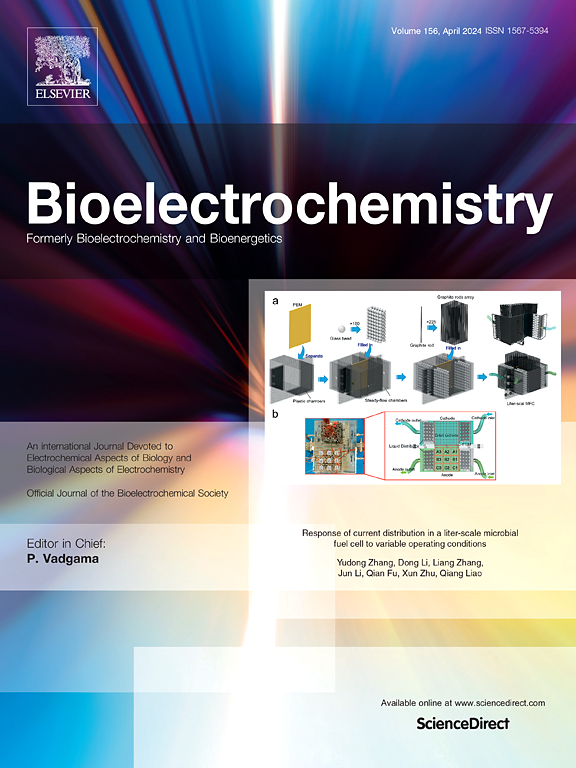利用微生物电化学移动床反应器在紫色光养细菌中光电异养生产聚羟基丁酸盐
IF 4.5
2区 化学
Q1 BIOCHEMISTRY & MOLECULAR BIOLOGY
引用次数: 0
摘要
由于其代谢的多样性,紫色光养细菌的混合群落可以利用电极作为电子供体来生产附加值产品。事实上,微生物电合成已经被证明是一种在光自养条件下生产聚羟基丁酸盐的合适策略。与传统的基于生物膜的电微生物学研究相比,流体状电极可以调节浮游微生物的代谢,以提高啤酒废水的生物降解率。在这项工作中,我们探索了利用光微生物电化学移动床反应器(mbe - mbr)在啤酒废水富集的混合群落中生产聚羟基丁酸盐。以乙酸为碳源,在阴极条件下(−0.8 V vs Ag/AgCl)运行生物电化学反应器,以评价i) PHB的生成和ii)生物电化学性能。我们观察到移动电极的阴极极化如何在PHB的产生中发挥关键作用,刺激微生物从导电床上直接吸收电子,并在电流收集器附近电化学产生氢气。总体而言,极化反应器在PHB生产速率方面优于非极化反应器四倍。此外,微生物群落分析显示,红假单胞菌属(Rhodopseudomonas sp.)和缓慢根瘤菌属(bryyrhizobium sp.)是主要属,与其他电活性属(如Geosporobacter sp.)结合,表明阴极移动床可以为生物炼制和增值产品生产提供可行的平台。本文章由计算机程序翻译,如有差异,请以英文原文为准。

Photoelectroheterotrophic production of polyhydroxybutyrate in purple phototrophic bacteria using a microbial electrochemical moving bed reactor
Due to its metabolic versatility, mixed communities of purple phototrophic bacteria could be exploited for production of added value products using an electrode as electron donor. Indeed, microbial electrosynthesis has already been proved as a suitable strategy for polyhydroxybutyrate production under photoautotrophic conditions. In contrast with classical biofilm-based electromicrobiology studies, fluid-like electrodes can tune planktonic microbial metabolism to enhance biodegradation rates in brewery wastewater. In this work we have explored polyhydroxybutyrate production in a mixed community enriched from brewery wastewater using a photo-microbial electrochemical moving bed reactor (photoME-MBR). The bioelectrochemical reactor was operated under cathodic conditions (−0.8 V vs Ag/AgCl) with acetate as carbon source as a mean to evaluate i) PHB production and ii) bioelectrochemical performance. We observed how a cathodic polarization of the moving electrode played a key role on PHB production stimulating both direct microbial electron uptake from the conductive bed and electrochemically produced hydrogen in the vicinity of the current collector. Overall, the polarized reactor outperformed the non-polarized reactor by four-fold regarding PHB production rate. In addition, microbial communities analysis revealed Rhodopseudomonas sp. and Bradyrhizobium sp. as main genera in combination with other electroactive genera like Geosporobacter sp. This work revealed that cathodic moving beds could present a feasible platform for biorefineries and added value products production.
求助全文
通过发布文献求助,成功后即可免费获取论文全文。
去求助
来源期刊

Bioelectrochemistry
生物-电化学
CiteScore
9.10
自引率
6.00%
发文量
238
审稿时长
38 days
期刊介绍:
An International Journal Devoted to Electrochemical Aspects of Biology and Biological Aspects of Electrochemistry
Bioelectrochemistry is an international journal devoted to electrochemical principles in biology and biological aspects of electrochemistry. It publishes experimental and theoretical papers dealing with the electrochemical aspects of:
• Electrified interfaces (electric double layers, adsorption, electron transfer, protein electrochemistry, basic principles of biosensors, biosensor interfaces and bio-nanosensor design and construction.
• Electric and magnetic field effects (field-dependent processes, field interactions with molecules, intramolecular field effects, sensory systems for electric and magnetic fields, molecular and cellular mechanisms)
• Bioenergetics and signal transduction (energy conversion, photosynthetic and visual membranes)
• Biomembranes and model membranes (thermodynamics and mechanics, membrane transport, electroporation, fusion and insertion)
• Electrochemical applications in medicine and biotechnology (drug delivery and gene transfer to cells and tissues, iontophoresis, skin electroporation, injury and repair).
• Organization and use of arrays in-vitro and in-vivo, including as part of feedback control.
• Electrochemical interrogation of biofilms as generated by microorganisms and tissue reaction associated with medical implants.
 求助内容:
求助内容: 应助结果提醒方式:
应助结果提醒方式:


